Study on spray granulation pre-alloyed W-Ni-Fe ternary alloy powder and radio frequency thermal plasma densification
Release time:
2025-09-04
As one of the typical representatives of high-density tungsten-based alloys, tungsten-nickel-iron (W-Ni-Fe) alloy has a wide range of applications in modern science and defense and civilian industries, such as radiation protection and guidance, industrial counterweights, nuclear energy and energy components, etc., due to its high density, low thermal expansion coefficient, corrosion resistance and good processing performance [1]. Most of the high-density W-Ni-Fe alloy parts are manufactured by traditional powder metallurgy sintering method, that is, the powders of each element are pre-mixed mechanically and then molded by molding, and then liquid phase sintering is used to make blanks, which are then processed into parts [6]. Additive manufacturing (AM) technology represented by selective laser melting (SLM) and selective electron beam melting (SEBM) has many advantages in the precision processing of complex components [7-8]. For additive manufacturing technology, the properties of powder materials (including fluidity, porosity, composition and oxygen content) have a crucial impact on the performance of their formed components. This technology requires the powder to have good fluidity and density. Therefore, studying the preparation process (including composition design and dense spheroidization process) and methods of dense spherical powder materials for additive manufacturing is of great significance and has broad application prospects for improving the performance of its components.
For the preparation of spherical powder materials for AM, the main methods currently used are atomization [9], plasma rotating electrode [10-12] and radio frequency thermal plasma (RF) spheroidization [13-15]. Compared with other methods, RF thermal plasma has the characteristics of high temperature and purity, and has significant advantages in the preparation of high-purity spherical powders of refractory systems (tungsten, molybdenum, tantalum and their alloys) [16-18]. Many researchers at home and abroad have used radio frequency thermal plasma to study the spheroidization of tungsten powder and related processes. For example, Boulos et al. [19] from Canada studied the spheroidization process of tungsten powder and other particles. The study found that the spheroidization rate of particles with a particle size of about 60 μm was not high, and some very fine particles would adhere to the surface. The analysis believed that this was due to the high pressure in the chamber causing some particles to evaporate due to heat. Yu et al. [20] studied the spheroidization of tungsten and tungsten-tantalum alloy powders and found that alloying elements can reduce microcracks during tungsten melting and rapid solidification. Wang et al. [21] used radio frequency thermal plasma to prepare spherical tungsten powder with good dispersion and smooth surface. The study found that the spheroidization rate was higher at a lower feed rate, and the spheroidization rate decreased with the increase of feed rate. Li et al. [22] used radio frequency thermal plasma spheroidization process to synthesize spherical dense tungsten particles, and further prepared porous tungsten matrix with uniform pore distribution. The study found that spherical dense tungsten particles are conducive to obtaining porous tungsten matrix with uniform pores. Currently, research on the spheroidization of pure tungsten powders using radiofrequency thermal plasma is more common, while studies on the spheroidization and densification of multicomponent tungsten-based alloy powders are rare.
In contrast, radiofrequency thermal plasma, with its high temperature and purity, offers significant advantages in the preparation of high-purity spherical powders of refractory materials (tungsten, molybdenum, tantalum, and their alloys) [16-18]. Many researchers at home and abroad have used radio frequency thermal plasma to study the spheroidization of tungsten powder and related processes. For example, Boulos et al. in Canada [19] studied the spheroidization process of tungsten powder and other particles. The study found that the spheroidization rate of particles with a particle size of about 60 μm was not high, and some extremely fine particles would adhere to the surface. The analysis believed that this was due to the high pressure in the chamber causing some particles to evaporate due to heat; Yu et al. [20] studied the spheroidization of tungsten and tungsten-tantalum alloy powders and found that alloying elements can reduce microcracks during tungsten melting and rapid solidification; Wang et al. [21] used radio frequency thermal plasma to prepare spherical tungsten powder with good dispersion and smooth surface. The study found that the spheroidization rate was higher at a lower feed rate, and the spheroidization rate decreased with the increase of feed rate; Li et al. [22] used radio frequency thermal plasma spheroidization process to synthesize spherical dense tungsten particles, and further prepared porous tungsten matrix with uniform pore distribution. The study found that spherical dense tungsten particles are conducive to obtaining porous tungsten matrix with uniform pores. Currently, research on the spheroidization of pure tungsten powder using radio frequency thermal plasma is more common, while studies on the spheroidization and densification of multicomponent tungsten-based alloy powders are rare.
This study combines spray granulation with radio frequency thermal plasma high-temperature densification spheroidization. W, Ni, and Fe powders are mixed in appropriate proportions and spray granulated to produce a W-Ni-Fe alloy powder with a specific composition ratio. The granulated and alloyed powder is then densified and spheroidized using radio frequency thermal plasma. The theoretical and process experiments on the densification of W-Ni-Fe alloy powder using radio frequency thermal plasma were conducted. Combined with powder performance testing and analysis, the effects of radio frequency thermal plasma on the morphology, microstructure, and porosity of the W-Ni-Fe alloy powder were investigated. These results provide valuable insights and guidance for exploring the compositional design of high-density tungsten-based W-Ni-Fe ternary alloys and for the densification and spheroidization of spray-granulated alloy powders.
1 Theoretical Calculation Model and Experimental Study
1.1 Theoretical Model of the Interaction between W-Ni-Fe Ternary Alloy Powder and Plasma
Numerical calculation methods were used to investigate the particle size evolution and motion trajectory of W-Ni-Fe ternary alloy powder during plasma densification and spheroidization, as well as the plasma flow field distribution. To simplify the calculation model, the following assumptions are made: (1) The thermal plasma generator system is a two-dimensional axisymmetric model, and the influence of the sheath and cooling water is not considered; (2) The thermal plasma is in local thermodynamic equilibrium (i.e., the temperature of the microscopic particles in the plasma is approximately equal) and is in a steady, laminar flow state; (3) Compared with the Joule heat term and the radiation heat term, the small terms in the control equation (pressure work, displacement current and viscous loss terms, etc.) are ignored, and the control equation can be described as [23-24]:

Where, u and v are the axial and radial velocity components, respectively; ρ, μ, λ, cp, σ are the density, viscosity, thermal conductivity, specific heat capacity and electrical conductivity of the plasma, respectively; h and p are the enthalpy and pressure, respectively; QJ and QR are the Joule heat and radiation heat per unit volume, respectively; Fz and Fr are the axial and radial components of the Lorentz force, respectively; Jc, Eθ, Bz and Br are the current density, angular electric field, axial and radial magnetic field, respectively, passing through the coil. Ignoring the collision heat transfer between powder particles and the internal thermal resistance, the particle heat transfer force model can be described as [27]:

In formulas (6) and (7): ρ and U are the plasma density and velocity, dp and Up are the particle size and movement velocity, respectively; ρp, CD, g are the particle density, resistance coefficient and gravitational acceleration, respectively; hf, T, Tp and Ta are the thermal conductivity coefficient, plasma temperature, particle temperature and ambient temperature, respectively; σS and εp are the Stefan-Boltzmann coefficient and radiation coefficient, respectively.
1.2 Pre-alloying and Plasma Densification of Precursor W-Ni-Fe Ternary Powder
W powder, Ni powder, and Fe powder with an average particle size of several microns were mixed in a mass ratio of 96:2.5:1.5 and then spray-dried and granulated at approximately 200°C to obtain a high-density tungsten-based 96W-2.5Ni-1.5Fe ternary alloy powder as the precursor. The 96W-2.5Ni-1.5Fe ternary alloy powder was densified and spheroidized using a radio frequency thermal plasma powder processing system developed by the Southwest Institute of Nuclear Physics. The system had a rated power of 100 kW, a frequency of 3 ± 0.5 MHz, and used argon (99.99%) as the working gas. The process principle and experimental parameters are shown in Figure 1 and Table 1, respectively.
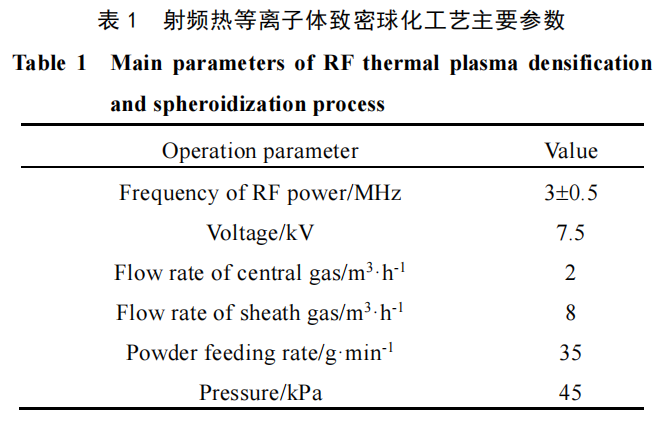
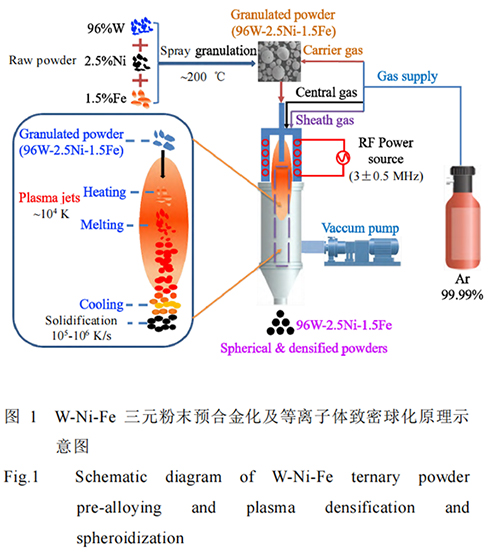 1.3 Performance Testing and Characterization
1.3 Performance Testing and Characterization
Magnetohydrodynamic (MHD) theory was used to calculate and analyze the plasma flow field and particle size changes after particle injection. Field emission scanning electron microscopy (SEM), metallographic microscopy, and energy dispersive X-ray spectroscopy (EDS) were used to analyze and characterize the morphology, microstructure, cross-sectional morphology, and composition of the W-Ni-Fe powder.
2 Results and Discussion
2.1 Performance Analysis of W-Ni-Fe Pre-alloyed Powder
The apparent SEM morphologies of the raw W powder and the spray-granulated W-Ni-Fe pre-alloyed powder are shown in Figure 2. The raw W powder exhibits irregular lumps, while the spray-granulated 96W-2.5Ni-1.5Fe powder exhibits a loose microstructure with irregular, spherical shapes, some of which are hemispherical. The powder has numerous cavities and a rough, loose surface. Some powders even exhibit depressions, nesting, or surface cracks (Figures 2b-2d).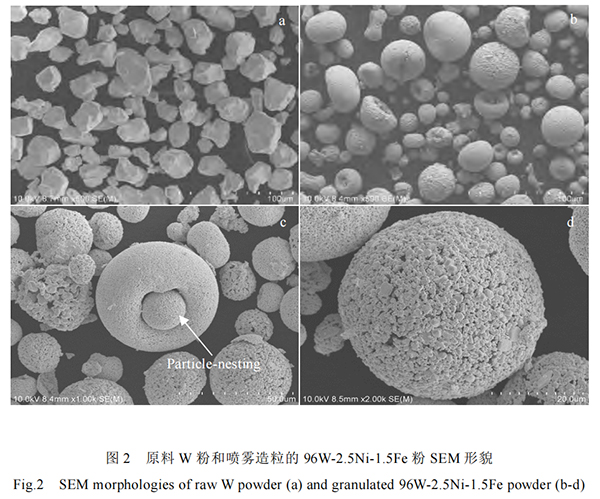
Further observation of the surface and interior of the 96W-2.5Ni-1.5Fe ternary alloy granulated powder revealed that multiple particles were bonded together into a single particle. The surface microstructure was relatively loose, exhibiting a "net-like" structure. Some powder particles were not even fully spherical, making them easily breakable and containing numerous internal pores, as shown in Figure 3. Therefore, while spray granulation can effectively control and optimize the elemental composition ratio of powder materials, the resulting granulated powder is typically loose and porous, brittle, and prone to cracking. This is extremely detrimental to subsequent powder processing methods such as powder metallurgy or additive manufacturing, as well as the mechanical and physical properties of the finished product. Therefore, densification and spheroidization can effectively address these issues.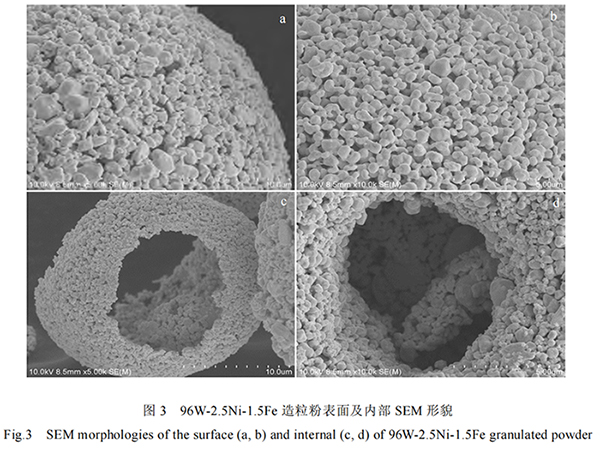
2.2 Theoretical Study of the Densification Process of 96W-2.5Ni-1.5Fe
Ternary Alloy Powder Using Radio Frequency Thermal Plasma. Melting granulated powders at high temperatures in radio frequency thermal plasma followed by cooling and solidification is an effective method for densification. Temperature and the interaction time between the particles and the plasma are two crucial factors influencing the densification effect. To this end, numerical calculations were used to investigate the flow field distribution characteristics of granulated 96W-2.5Ni-1.5Fe powder during the densification and spheroidization process after injection into the plasma. The results are shown in Figure 4. Figure 4a shows that the temperature distribution of the plasma exhibits a low temperature at the central axis, which gradually increases and then decreases with increasing radial distance, with the maximum temperature remaining around 104 K. This is due to the skin effect of high-frequency electromagnetic induction, which results in higher temperatures near the coil. In addition, due to the magnetic pumping effect of the RF electromagnetic field, the plasma velocity exhibits a low top velocity, which helps prolong the interaction time between the particles and the plasma. As the flow field progresses, the velocity gradually increases, reaching a maximum velocity of approximately 23.8 m/s (Figure 4b). Therefore, the extremely high temperature and low velocity flow field distribution characteristics are beneficial for the densification and spheroidization of powder particles.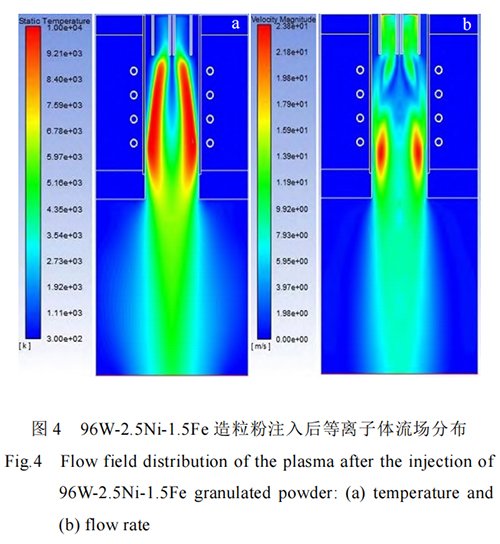 The dynamic behavior of particles in the plasma and the heat exchange effect between them and the plasma are another important factor affecting the densification and spheroidization effect. The motion trajectory and particle size variation of 96W-2.5Ni-1.5Fe granulated powder in the plasma are shown in Figure 5. The study found that when the particles are upstream of the plasma, their movement is mainly concentrated in the center, and they gradually diffuse to the sides as they move downstream. The particle size gradually decreases with increasing axial distance, theoretically confirming the high temperature of the plasma has a densifying effect on the powder. Analysis suggests that when particles are introduced into the plasma from the central axis, their movement is more concentrated. The eddy currents generated by the high-frequency electromagnetic field draw the powder to the sides, causing the particles to diffuse. Based on the distribution characteristics of the temperature field, this diffusion of particles to the sides is more conducive to efficient heat transfer and melting. After heat exchange with the plasma, droplets are formed and then shrink, resulting in a reduction in the particle size of the granulated powder and densification.
The dynamic behavior of particles in the plasma and the heat exchange effect between them and the plasma are another important factor affecting the densification and spheroidization effect. The motion trajectory and particle size variation of 96W-2.5Ni-1.5Fe granulated powder in the plasma are shown in Figure 5. The study found that when the particles are upstream of the plasma, their movement is mainly concentrated in the center, and they gradually diffuse to the sides as they move downstream. The particle size gradually decreases with increasing axial distance, theoretically confirming the high temperature of the plasma has a densifying effect on the powder. Analysis suggests that when particles are introduced into the plasma from the central axis, their movement is more concentrated. The eddy currents generated by the high-frequency electromagnetic field draw the powder to the sides, causing the particles to diffuse. Based on the distribution characteristics of the temperature field, this diffusion of particles to the sides is more conducive to efficient heat transfer and melting. After heat exchange with the plasma, droplets are formed and then shrink, resulting in a reduction in the particle size of the granulated powder and densification.
2.3 Experimental Study on Densification of 96W-2.5Ni-1.5Fe Ternary Alloy Powder by Radio Frequency Thermal Plasma
Spray-granulated 96W-2.5Ni-1.5Fe ternary alloy powder was treated in radio frequency thermal plasma. The results showed that the powder exhibited a more regular spherical shape after plasma treatment. The surface porosity and looseness of the dense spherical powder were reduced, but some particles remained undensified or had defects, as shown in Figures 6a and 6b. Therefore, the overall performance of the 96W-2.5Ni-1.5Fe ternary alloy granulated powder was improved after radio frequency thermal plasma treatment. Analysis suggests that due to the high temperature of the RF thermal plasma, intense heat exchange occurs with the plasma flow field, causing the powder to melt. The high temperature rapidly melts the interior and surface of the granulated powder particles, forming droplets. These droplets then shrink under surface tension during rapid cooling, forming dense spherical particles.
Further observation of the surfaces of some defective powder particles (Figure 6c) reveals micropores and surface wrinkles or lines. Analysis suggests that the molten droplets formed by the high-temperature plasma melting of the powder particles exhibit uneven surface tension distribution and thermal stress release during the cooling process due to differences in the physical properties of the various elements. Alternatively, localized areas of the particle surface are not effectively heated and melted, ultimately leading to wrinkles and lines during the cooling, shrinkage, and solidification process.
Furthermore, the EDS spectrum of the 96W-2.5Ni-1.5Fe powder after RF thermal plasma treatment (Figure 6d) reveals that the Ni and Fe phases between the W grains within the particles contain a high content of W. This suggests that a solid solution state likely exists between the W grains. Therefore, the high temperature of the thermal plasma effectively fuses the three elements, W, Ni, and Fe.
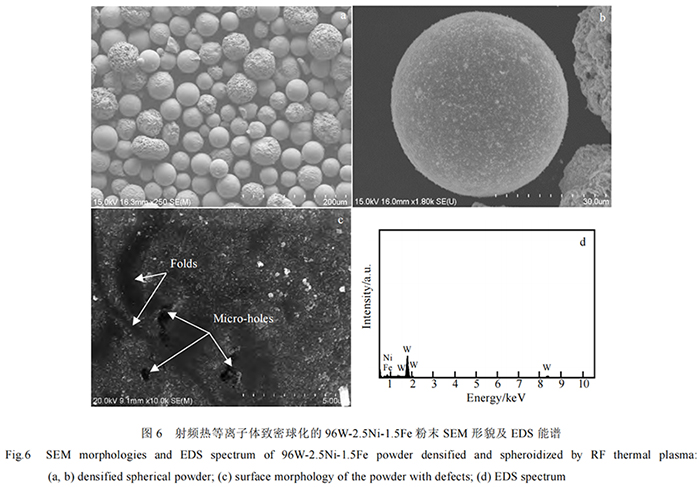
To further investigate the internal microstructure of the particles, a sample of the 96W-2.5Ni-1.5Fe ternary alloy powder treated with RF thermal plasma densification and spheroidization was mounted and polished, and its cross-section and internal microstructure were observed. The cross-section microstructure is shown in Figure 7. The results show that the internal cross-section of the particles after densification and spheroidization exhibits good density and high sphericity, with some particles containing internal pores. This phenomenon confirms that the internal structure of the 96W-2.5Ni-1.5Fe ternary alloy spray-granulated powder can also achieve a good melting state during the plasma flow field, leading to densification. At the same time, some particles still have small “loose pores” or “micropores” inside, as shown in Figures 7c and 7d.This may be because there are many pores inside the raw material granulation powder, which is filled with a large amount of gas before entering the plasma. After being exposed to the high temperature of the plasma, the gas expands due to heat and is released outward. Because the interaction time between the particles and the high temperature zone of the plasma is short, the high temperature gas inside is unable to completely discharge the droplets in time, resulting in the formation of "loose pores" during the cooling and solidification process. The presence of micropores within the spheroid is influenced by a variety of factors. Analysis suggests that this is primarily due to the large size of some larger particles, resulting in insufficient heat transfer between them and the plasma, leading to incomplete melting. Furthermore, theoretical calculations of the plasma flow field distribution (Figure 4) and the particle trajectory during densification (Figure 5) indicate that when the particle size is large, its trajectory is primarily concentrated near the central axis, as shown in Figure 5. Combined with the plasma temperature field distribution (Figure 4a), it is clear that the larger particles, affected by their own gravity, are unable to enter the plasma core's high-temperature zone and be heated during the densification process. Furthermore, the short heat exchange time between them and the plasma results in poor internal heat absorption. Smaller particles, however, are lighter due to their own gravity, making them more easily transported to the core's high-temperature zone under the influence of the plasma flow field and effectively melted. Generally speaking, the melting effect of particles under high plasma temperatures is inversely proportional to their size. Larger particles can only be fully heated and melted at sufficiently high temperatures and for longer heating times. Therefore, the effectiveness of particle densification and spheroidization depends primarily on the degree of melting in the plasma flow field. The particle size, particle trajectory, and endothermic melting effect of the granulated powder are the primary factors influencing the final powder properties.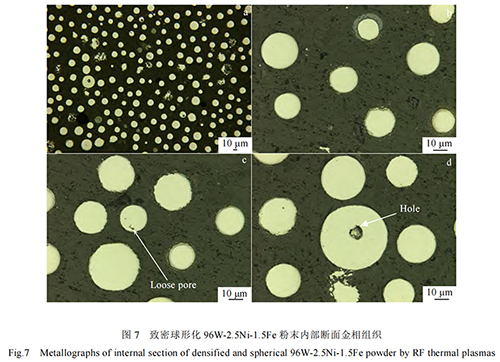
Further research also revealed that a very small number of particles after plasma densification and spheroidization contain large pores within them, indicating poor densification, as shown in Figure 8. Because the trajectory of a large number of particles entering the plasma is a random process, ensuring effective melting and densification of each particle during RF thermal plasma densification and spheroidization is difficult. Furthermore, various factors, including individual particle gravity, particle size, and physical properties (thermal conductivity, heat transfer coefficient, etc.) resulting from varying elemental ratios, can lead to defects such as pores within a very small number of powder particles.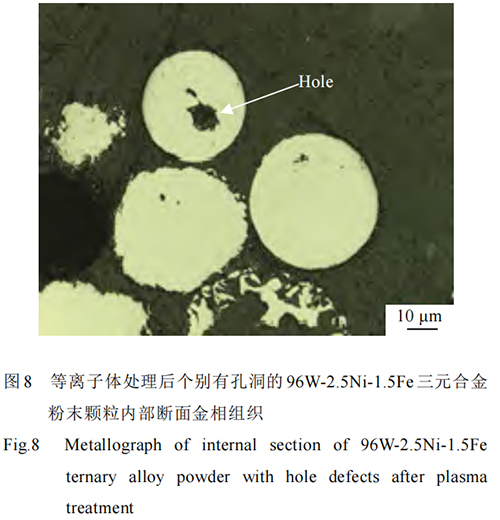 3 Conclusions
3 Conclusions
1) While spray granulation can effectively coordinate and control the ratios of multiple elements, the resulting powder particles often exhibit a loose microstructure with a rough surface, and some even exhibit depressions or cracks, which impacts subsequent processing and the performance of finished parts. RF thermal plasma treatment significantly densifies and spheroidizes these particles. Therefore, the combination of spray granulation and RF thermal plasma densification and spheroidization can effectively improve the overall performance of the powder.
2) The high temperature of RF thermal plasma causes the W, Ni, and Fe elements of the 96W-2.5Ni-1.5Fe ternary alloy powder to undergo solid solution within the particles, effectively fusing the elements.
3) Some 96W-2.5Ni-1.5Fe ternary alloy powder particles exhibited surface wrinkles and micropores after RF thermal plasma densification. This may be due to various factors, including uneven surface tension distribution caused by differences in the physical properties of the elements, thermal stress release during the cooling and solidification of the molten droplets, insufficient heat transfer between some larger particles and the plasma, and uneven release of small amounts of gas from the pores within the granulated powder.
Citation Information
Rare Metal Materials and Engineering, Vol. 52, No. 10, October 2023
Tungsten-nickel-iron is a tungsten-based heavy alloy, a powder metallurgy material produced through a specific process using tungsten (W), nickel (Ni), and iron (Fe). It combines the high density and strength of tungsten with the toughness of the nickel-iron binder phase, making it an important structural material in the industrial field.
Stardust Technology's spherical W-Ni-Fe alloy powder, produced using RF plasma spheroidization, features high purity, low oxygen content, high sphericity, a smooth surface, no satellites, uniform particle size distribution, excellent flow properties, and high bulk and tap densities.http://en.stardusttech.cn/products/107.html
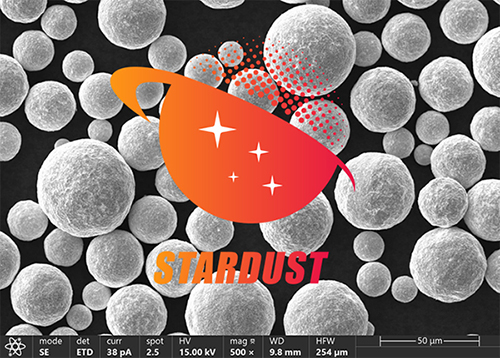
For more details, please contact Vicky Zhang at +86-13318326185

